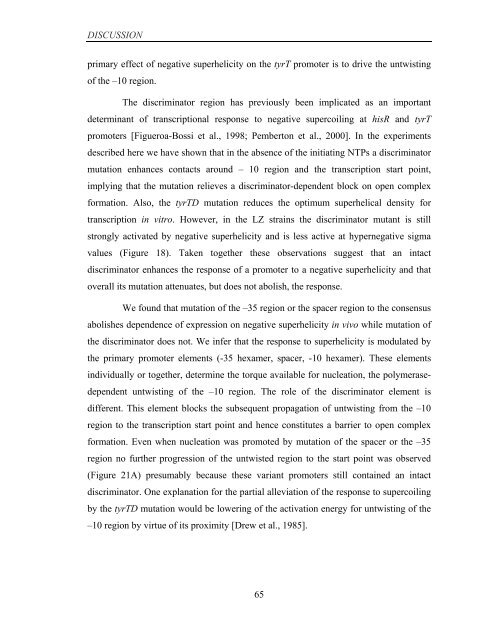Coordinated regulation of gene expression by E ... - Jacobs University
Coordinated regulation of gene expression by E ... - Jacobs University
Coordinated regulation of gene expression by E ... - Jacobs University
You also want an ePaper? Increase the reach of your titles
YUMPU automatically turns print PDFs into web optimized ePapers that Google loves.
DISCUSSION<br />
primary effect <strong>of</strong> negative superhelicity on the tyrT promoter is to drive the untwisting<br />
<strong>of</strong> the –10 region.<br />
The discriminator region has previously been implicated as an important<br />
determinant <strong>of</strong> transcriptional response to negative supercoiling at hisR and tyrT<br />
promoters [Figueroa-Bossi et al., 1998; Pemberton et al., 2000]. In the experiments<br />
described here we have shown that in the absence <strong>of</strong> the initiating NTPs a discriminator<br />
mutation enhances contacts around – 10 region and the transcription start point,<br />
implying that the mutation relieves a discriminator-dependent block on open complex<br />
formation. Also, the tyrTD mutation reduces the optimum superhelical density for<br />
transcription in vitro. However, in the LZ strains the discriminator mutant is still<br />
strongly activated <strong>by</strong> negative superhelicity and is less active at hypernegative sigma<br />
values (Figure 18). Taken together these observations suggest that an intact<br />
discriminator enhances the response <strong>of</strong> a promoter to a negative superhelicity and that<br />
overall its mutation attenuates, but does not abolish, the response.<br />
We found that mutation <strong>of</strong> the –35 region or the spacer region to the consensus<br />
abolishes dependence <strong>of</strong> <strong>expression</strong> on negative superhelicity in vivo while mutation <strong>of</strong><br />
the discriminator does not. We infer that the response to superhelicity is modulated <strong>by</strong><br />
the primary promoter elements (-35 hexamer, spacer, -10 hexamer). These elements<br />
individually or together, determine the torque available for nucleation, the polymerasedependent<br />
untwisting <strong>of</strong> the –10 region. The role <strong>of</strong> the discriminator element is<br />
different. This element blocks the subsequent propagation <strong>of</strong> untwisting from the –10<br />
region to the transcription start point and hence constitutes a barrier to open complex<br />
formation. Even when nucleation was promoted <strong>by</strong> mutation <strong>of</strong> the spacer or the –35<br />
region no further progression <strong>of</strong> the untwisted region to the start point was observed<br />
(Figure 21A) presumably because these variant promoters still contained an intact<br />
discriminator. One explanation for the partial alleviation <strong>of</strong> the response to supercoiling<br />
<strong>by</strong> the tyrTD mutation would be lowering <strong>of</strong> the activation energy for untwisting <strong>of</strong> the<br />
–10 region <strong>by</strong> virtue <strong>of</strong> its proximity [Drew et al., 1985].<br />
65
















